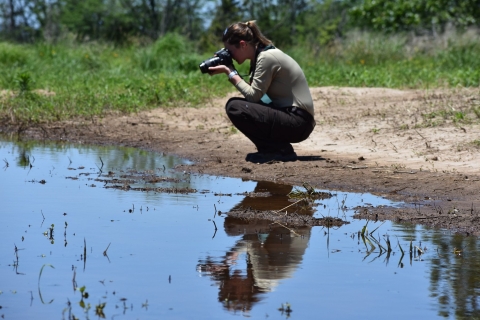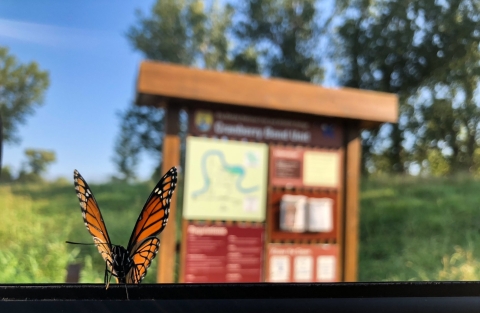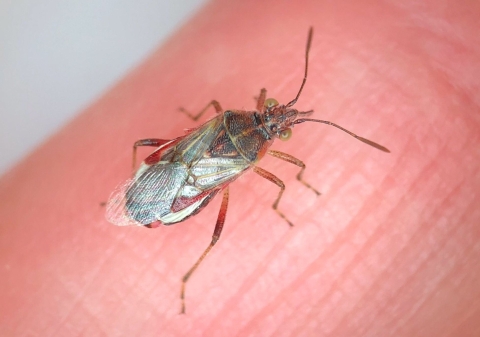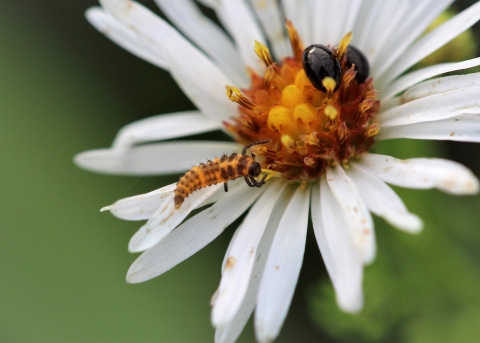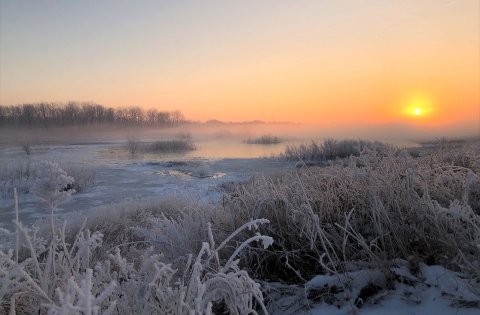Meet Ashley Riedel — former Korean language and intelligence analyst who for several years was a wildlife biologist at the U.S. Fish and Wildlife Service field office in Columbia, Missouri.
Riedel values photography as a way to slow down, see more attentively and connect with nature. She began using photography to record phenological (seasonal) changes during endangered species surveys at Guam National Wildlife Refuge in the western Pacific.
Before leaving the Fish and Wildlife Service, she used her camera to confirm species identifications during waterfowl, grassland and forest bird surveys, often at Big Muddy National Fish and Wildlife Refuge along the Missouri River. She used her photos in posts about flora and fauna on the refuge’s Facebook page, too.
For this story, we asked Riedel to select a few of her favorite photos from the refuge and reflect briefly about them.
“I will never forget this moment. It was my first day at Big Muddy, and I arrived on site early for a day of fieldwork. While I waited for my new colleagues, I rolled my car windows down to take in the sights and sounds, and this butterfly landed on my windowsill. It wasn’t until later that I learned the butterfly was not a monarch, but rather a viceroy. It was my first local lesson in mimicry. It taught me that some things aren’t quite as they seem, but rather require a closer look.”
“I was out walking along a tallgrass prairie trail during my lunch break one day when this bug flew into my hair. At first, I was startled. My initial reaction was to swat it away. However, not knowing what it was, I took my time and gently removed it. Once on my hand, the insect seemed calm and content to remain there. So I decided to take a closer look under the microscope. To my surprise, this dull brown-looking scentless plant bug was actually quite colorful — even beautiful in a way. This photo served as the inspiration for what would become a weekly #MicroMonday Facebook post to help our virtual visitors find inspiration in the often-overlooked and brushed aside.”
“If you were to ask people on the street to name a beetle, a ladybug likely would come to mind. But how many people would be able to identify the insect toward the left in this photo, even though they’re one and the same? When I first spotted this ladybug larva, I also wasn’t sure what it was. While these juveniles may not yet don their recognizable and arguably more fashionable shell, they certainly can spruce up your yard. Because they prefer aphids over pollen, they have been known to bring plants back from the brink of an early aphid-induced death. That’s an opportunity I happily gave another ladybug larva I found in my own yard, which saved my milkweed plants in time for fall monarch butterfly migration.”
“It was a hot and muggy summer day on the refuge, and I was out on a plant survey when I noticed a lot of activity around some beautiful vervain blooms. As I always say: Follow the flowers! After an initial investigation, I observed a dragonfly that I assumed was on the prowl for some prey. Instead, the dragonfly remained perched on the vervain in an odd position with its abdomen awkwardly lifted toward the sky. I snapped this shot and brought it back to my office for further research. I learned that, much like me, the dragonfly was hot that day, too. To cool off, it was assuming an obelisk position, effectively reducing the amount of its body surface area exposed to the sun. Since that day, I have viewed my photographs as an ecological and ethological treasure trove.”
“As you probably can tell by now, I love photographing the smaller, often unnoticed or misunderstood side of life — especially if there’s a twist. This soldier beetle did not disappoint. Despite its name and bright coloration, which serves as a warning signal to potential predators, this solider beetle is harmless and lives mostly on flower power. It’s an efficient pollinator too.”
“Although I love photographing insects and reframing them in an artful way, I thoroughly enjoy the challenge birds pose. I initially began photographing birds for species identification purposes but quickly fell in love with the Pokémon Go-like nature of it all. I heard this downy woodpecker before I saw it flittering through the forest. Between its quick movements and the maze of vegetation around us, I thought for sure I wasn’t going to ‘catch’ it. But before I could blink, he landed on a twig and I snapped this photo of him using his long tongue to probe for insects. As it happens, males of this species stick to smaller branches and twigs, leaving the females to forage on larger branches and tree trunks — a fact I kept in my back pocket for future outings.”
“I was surveying around Thanksgiving one year when I noticed this squirrel pigging out on berries. Normally I don’t get too excited when I see squirrels because they’re common around the refuge, but there was something about the way this one was reaching for this sweet treat that I could identify with. This squirrel reminded me that no matter how common a species is, there’s something we can all connect with in nature. After all, we all have to eat.”
“Early one morning, my colleague and I headed out for a winter waterfowl survey. It was the first frost of the season, and we were eager to see what we could find. As the dark lifted and we crossed the levee to our survey site, the cold wasn’t the only thing that was breathtaking. Unfortunately, I’d left the refuge camera behind. But sometimes the best camera is the one you have with you. So I took out my cell phone and snapped this shot just before the fog lifted. It turned out to be a view that I’ll remember for winters to come.”
More photoGRAPHY tips Visit a national wildlife refuge


